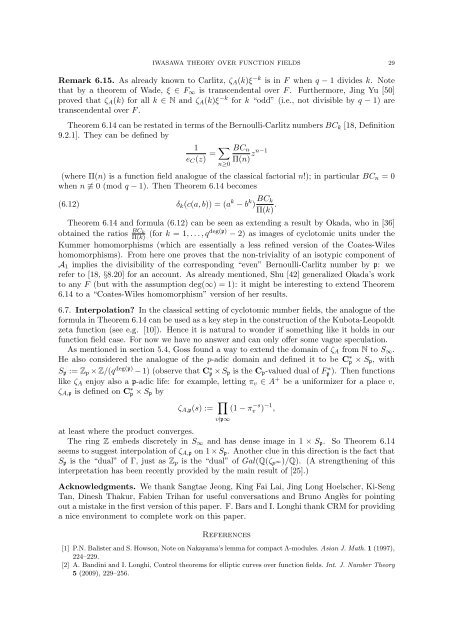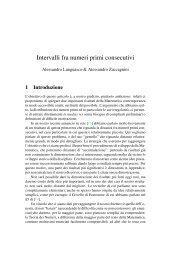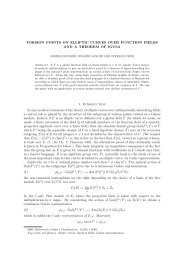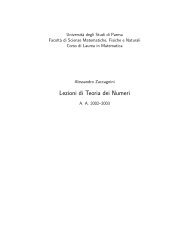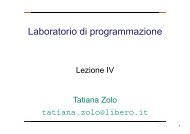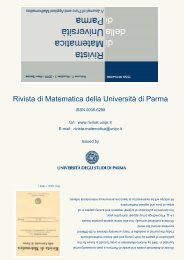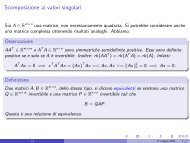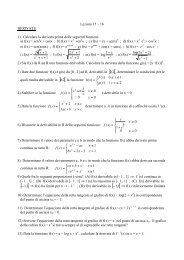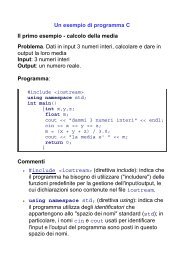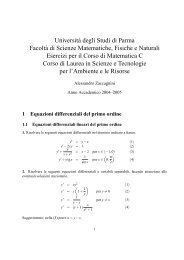ASPECTS OF IWASAWA THEORY OVER FUNCTION FIELDS 1 ...
ASPECTS OF IWASAWA THEORY OVER FUNCTION FIELDS 1 ...
ASPECTS OF IWASAWA THEORY OVER FUNCTION FIELDS 1 ...
You also want an ePaper? Increase the reach of your titles
YUMPU automatically turns print PDFs into web optimized ePapers that Google loves.
<strong>IWASAWA</strong> <strong>THEORY</strong> <strong>OVER</strong> <strong>FUNCTION</strong> <strong>FIELDS</strong> 29Remark 6.15. As already known to Carlitz, ζ A (k)ξ −k is in F when q − 1 divides k. Notethat by a theorem of Wade, ξ ∈ F ∞ is transcendental over F . Furthermore, Jing Yu [50]proved that ζ A (k) for all k ∈ N and ζ A (k)ξ −k for k “odd” (i.e., not divisible by q − 1) aretranscendental over F .Theorem 6.14 can be restated in terms of the Bernoulli-Carlitz numbers BC k [18, Definition9.2.1]. They can be defined by1e C (z) = ∑ n≥0BC nΠ(n) zn−1(where Π(n) is a function field analogue of the classical factorial n!); in particular BC n = 0when n ≢ 0 (mod q − 1). Then Theorem 6.14 becomes(6.12) δ k (c(a, b)) = (a k − b k ) BC kΠ(k) .Theorem 6.14 and formula (6.12) can be seen as extending a result by Okada, who in [36]obtained the ratios BC kΠ(k) (for k = 1, . . . , qdeg(p) − 2) as images of cyclotomic units under theKummer homomorphisms (which are essentially a less refined version of the Coates-Wileshomomorphisms). From here one proves that the non-triviality of an isotypic component ofA 1 implies the divisibility of the corresponding “even” Bernoulli-Carlitz number by p: werefer to [18, §8.20] for an account. As already mentioned, Shu [42] generalized Okada’s workto any F (but with the assumption deg(∞) = 1): it might be interesting to extend Theorem6.14 to a “Coates-Wiles homomorphism” version of her results.6.7. Interpolation? In the classical setting of cyclotomic number fields, the analogue of theformula in Theorem 6.14 can be used as a key step in the construction of the Kubota-Leopoldtzeta function (see e.g. [10]). Hence it is natural to wonder if something like it holds in ourfunction field case. For now we have no answer and can only offer some vague speculation.As mentioned in section 5.4, Goss found a way to extend the domain of ζ A from N to S ∞ .He also considered the analogue of the p-adic domain and defined it to be C ∗ p × S p , withS p := Z p × Z/(q deg(p) − 1) (observe that C ∗ p × S p is the C p -valued dual of Fp ∗ ). Then functionslike ζ A enjoy also a p-adic life: for example, letting π v ∈ A + be a uniformizer for a place v,ζ A,p is defined on C ∗ p × S p byζ A,p (s) := ∏(1 − πv −s ) −1 ,v∤p∞at least where the product converges.The ring Z embeds discretely in S ∞ and has dense image in 1 × S p . So Theorem 6.14seems to suggest interpolation of ζ A,p on 1 × S p . Another clue in this direction is the fact thatS p is the “dual” of Γ, just as Z p is the “dual” of Gal(Q(ζ p ∞)/Q). (A strengthening of thisinterpretation has been recently provided by the main result of [25].)Acknowledgments. We thank Sangtae Jeong, King Fai Lai, Jing Long Hoelscher, Ki-SengTan, Dinesh Thakur, Fabien Trihan for useful conversations and Bruno Anglès for pointingout a mistake in the first version of this paper. F. Bars and I. Longhi thank CRM for providinga nice environment to complete work on this paper.References[1] P.N. Balister and S. Howson, Note on Nakayama’s lemma for compact Λ-modules. Asian J. Math. 1 (1997),224–229.[2] A. Bandini and I. Longhi, Control theorems for elliptic curves over function fields. Int. J. Number Theory5 (2009), 229–256.


